Say, what exactly is it about a boardwalk of luxury villas perched on top of the endless blue Indian Ocean that makes Miles & Points fanatics so weak in the knees?
Even after visiting the Maldives for myself, I’m still not sure about the answer to this question, but I can at least say that I fully understand the hype.
After my glowing two-part review of the JW Marriott Maldives (Part 1 and Part 2), I wanted to follow-up with a separate discussion of the costs involved in planning your dream trip to the overwater villas of the Maldives, as well as whether or not this kind of trip is “worth it” and how the answer might vary depending on your travel preferences and motivation for collecting points in the first place.
You can also watch this video that I made a while back that guides you through the specific costs and credit card strategies involved in booking a dream trip to the Maldives:
In This Post
- Resort
- Inter-Island Transportation
- On-Property Spending
- Cost Breakdown: A Frugal Trip to the Maldives
- Cost Breakdown: A Lavish Trip to the Maldives
- Is a Trip to the Maldives Worth It?
- Conclusion
Maldives Travel Costs – Resort
Before we dive into an in-depth cost breakdown, I wanted to cover a few key characteristics of the Maldives’ resorts that set it apart from any other oceanside resort that you might visit.
To restrict our focus to the Maldives themselves, I’ll be glossing over the costs of booking flights, since I’ll be assuming that you can figure that part out on your own using your preferred points currency, whether it’s an Aeroplan Mini-RTW on a mix of Etihad Airways, Turkish Airlines, and Singapore Airlines, or perhaps an Asia Miles redemption on Qatar Airways Qsuites.
(I’ll also note that our discussion here will be centred around the luxury resorts of the Maldives, although it’s entirely possible to travel to the Maldives on a shoestring budget, getting around the islands via local ferries and staying at cheaper guesthouses along the way.)
Let’s begin with the room rates at these resorts. Because the overwater villas of the Maldives are so widely revered among the world’s leading “dream destinations”, the resorts are able to command some truly eye-popping nightly room rates. Rates of US$1,000–2,000 for base-level beach villas are not at all uncommon, and the prices only get higher when you look at the overwater villas.

Clearly, the preferred solution among savvy travellers is to redeem hotel rewards points for resorts that are part of major chains. To that end, Marriott Bonvoy allows members to redeem points for the following resorts:
- Sheraton Maldives Half Moon Bay: Category 6 (40,000, 50,000, or 60,000 points per night)
- Westin Maldives Miriandhoo: Category 7 (50,000, 60,000, or 70,000 points per night)
- W Maldives: Category 8 (70,000, 85,000, or 100,000 points per night)
- JW Marriott Maldives: Category 8 (70,000, 85,000, or 100,000 points per night)
- St. Regis Maldives Vommuli: Category 8 (70,000, 85,000, or 100,000 points per night)
Hilton Honors allows members to redeem points for the following resorts:
- SAii Lagoon Maldives: 85,000 points per night
- Conrad Maldives Rangali Island: 95,000 points per night
- Waldorf Astoria Maldives Ithaafushi: 120,000 points per night
Marriott and Hilton are probably the “easiest” loyalty programs for Canadians to earn points and redeem for a memorable stay in the Maldives. However, many of the other major hotel chains also have properties scattered around the archipelago as well, such as the Park Hyatt Maldives Hadahaa, the InterContinental Maldives Maamunagau, and the Fairmont Maldives.
Maldives Travel Costs – Inter-Island Transportation
Aside from the room rate, another significant cost component will be the transportation costs between Malé – whose Velana International Airport handles all international flights into the island nation – and your resort.
Depending on how far away your resort is, the inter-island journey might take place on either a seaplane or a speedboat, and in both cases the costs are often extremely exorbitant.
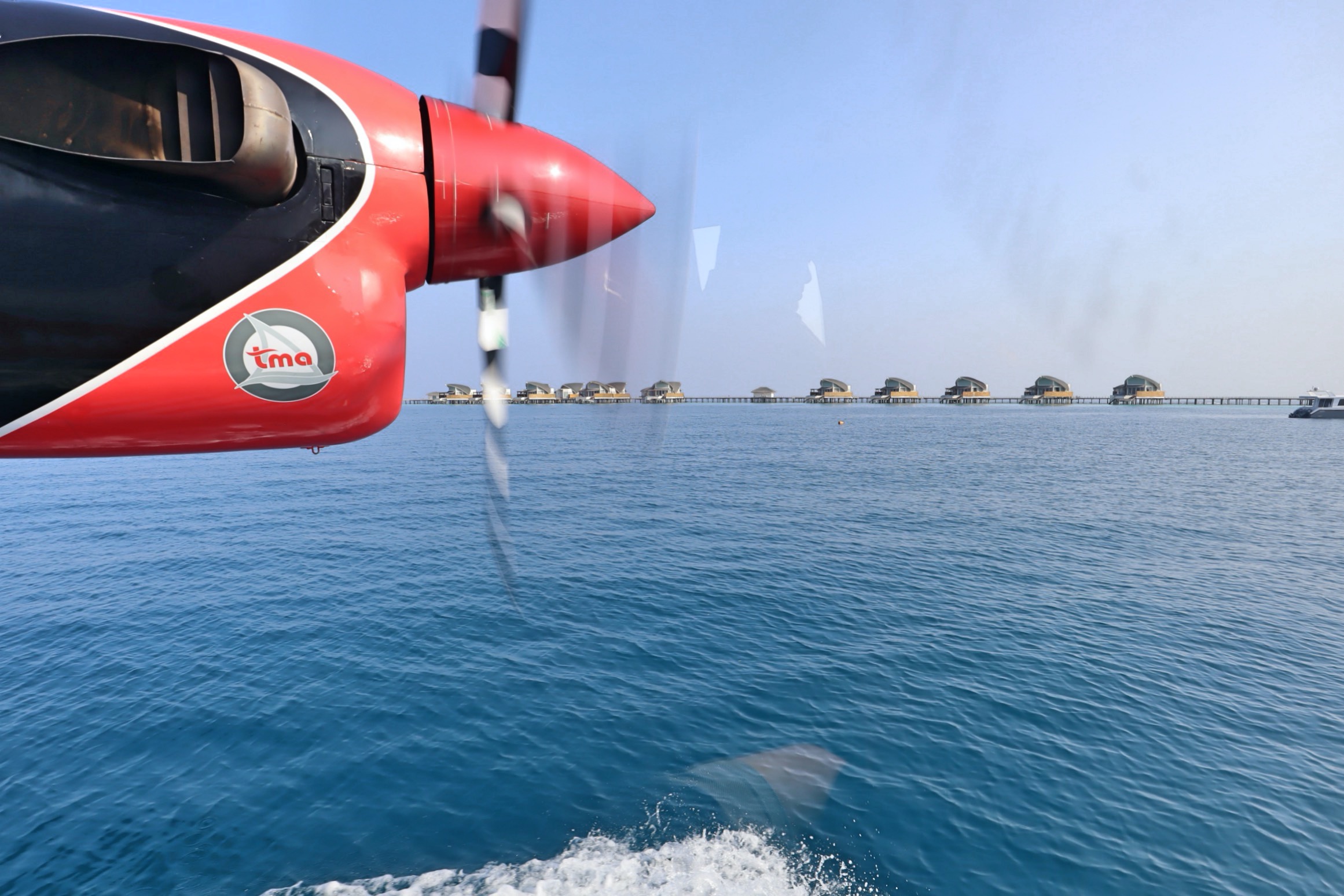
For example, on Marriott’s side, the St. Regis, JW Marriott, W, and Westin charge US$745, US$600, US$505, and US$475 per adult for the round-trip seaplane, respectively.
Over on Hilton’s side, the Waldorf Astoria’s luxury yacht costs a staggering US$738 per adult for the round-trip journey (and no, there’s no option to choose the dinghy boat instead). The Conrad will cost US$526 for the seaplane journey.
(Both the Sheraton and the SAii Lagoon are significantly closer to Malé and therefore command a much more reasonable speedboat fee of about US$100–150 per person. However, don’t forget the adage of “you get what you pay for” – if you’re going all-out on a trip to the Maldives, you’d most likely want to splurge a little on the more exclusive and luxurious resorts farther away.)
Maldives Travel Costs – On-Property Spending
Then, let’s talk about the on-property costs. This is where the costs can truly start to add up very quickly, and it all boils down to the reality that staying at a Maldives resort represents the textbook definition of a “captive market”.
If you’re staying at a luxury resort elsewhere in the world – say, the St. Regis Bali – you can always venture off the property if you’d rather not succumb to the resort’s steep prices of food, drinks, activities, spa treatments, etc.
(Indeed, right opposite the St. Regis Bali is a fantastic Chinese seafood restaurant where you can indulge in as much chilli crab as you want without a shred of guilt about the impact on your wallet.)
In the Maldives, however, you really have no choice but to consume from the resort’s on-property outlets. And that’s because… you’re surrounded by an ocean. Where are you going to go?

Of course, knowing that their guests are facing a captive market, the Maldives’ resorts price things the way that free-market economics would obligate them to: with an extremely significant markup, reflecting the high underlying costs of operating a resort in the middle of the ocean, and then some.
(And as a general practice, most Maldives resorts will automatically tack on a 22% surcharge on all on-property spending, which consists of 12% GST and 10% service charge. Prices are therefore commonly denoted with “++” at the end, reminding guests of the additional surcharges.)
Therefore, for any travellers who aren’t entirely made of money, a trip to the Maldives bears some careful strategic thinking:
- Elite status (at least Marriott Platinum Elite or Hilton Gold, and ideally Marriott Titanium Elite or Hilton Diamond, if possible) is essential for many reasons:
- To save on the cost of breakfast, by selecting it as your elite welcome amenity
- To have a chance of a complimentary upgrade to an overwater villa, in case you didn’t book one directly
- To save 20+% on the cost of dining, in the case of the Marriott resorts and their Restaurants + Bars benefit in the Asia-Pacific
- It may be wise to bring with you some snacks, non-alcoholic drinks, and non-perishable food so that you don’t have to eat dinner every single night. A common practice is to stock up on packages of instant noodles at your final port of call before arriving in Malé – as long as your total luggage weight does not exceed the per-person allowance of 30kg for the seaplane transfer!
You’ll notice that I mentioned bringing along some non-alcoholic drinks. Unfortunately, the Maldives, as a predominantly Muslim nation, enforces extremely strict controls on alcohol consumption, and imposes hefty penalties on anyone bringing liquor into the country.
As you might imagine, resorts are granted an exceptional liquor license, but the markup on alcohol will be significantly greater than the markup on food due to the local regulations.
To illustrate, when I looked at the final bill for our stay at the JW Marriott Maldives, I noticed that the private beachside dinner that had cost me US$650 for two people was in fact composed of US$250 for the food and US$400 for the bottle of champagne!
Since you can’t bring your own liquor with you, there’s only one option if you want to get a bit of a buzz going: pay up.
Cost Breakdown: A Frugal Trip to the Maldives
Let’s think about the absolute minimum dollar amount that you could spend and still treat yourself to a very nice visit to the overwater villas of the Maldives.
We’ll assume a five-night stay at one of the points-affiliated resorts, in order to take advantage of the “Stay 5, Pay for 4” benefit that’s offered by both Marriott and Hilton. Let’s also assume that you want to get away from Malé a little bit and stay at one of the resorts in the outer islands instead (thus ruling out the Sheraton and the SAii Lagoon).
Looking at the other resorts, the cheapest option is most likely the Westin Maldives, a Category 7 Marriott Bonvoy property that can be booked for 50,000 Bonvoy points per night at off-peak rates.
This books into a Beach Villa rather than an Overwater Villa, but as a frugal-minded traveller, you’ve certainly mastered the art of “suite-talking” your way to a nice upgrade.

A five-night stay, then, will run you 200,000 Bonvoy points, which can be earned quite easily by combining a few of the Canadian- and US-issued Amex Bonvoy credit cards across you and your partner.
For simplicity, let’s assume you’re each applying for the personal and business versions of the Amex Bonvoy cards in Canada (priced at $120 and $150, respectively).
(However, if you’re starting from scratch without elite status, then there’s a real case to be made to mix in some of the US Bonvoy cards, whose 15 elite qualifying nights stack with each other across the personal and business versions, to help you get to Platinum Elite status faster.)
Anyway, that brings our total outlay in credit card annual fees to $540. To that, we must add the Westin’s seaplane fee of US$475 per adult, or US$950 (C$1,254) per couple.
And beyond that, well, there’s not much more to it for the frugal-minded traveller, is there?
Your elite status will take care of breakfast every morning, and as is absolutely your right, you’d show up 20 minutes before breakfast ends and help yourself to a gargantuan feast to slowly nibble on until lunchtime.

That should easily tide you over until the evening, when your pre-bought snacks and gourmet instant noodles will provide enough sustenance to last you until the next morning.
What about alcohol? You might be treated to a complimentary bottle of wine upon arrival, or perhaps a Happy Hour cocktail party for elite members on one of the evenings, but otherwise, the heavily marked-up bottles are far out of your price range. The sunset views are intoxicating enough.
If we add on a token $100 to cover the costs of the non-perishables you’re bringing with you, then a trip to the luxury overwater resorts of the Maldives can be done for as little as $1,894 per couple.
Cost Breakdown: A Lavish Trip to the Maldives
On the other hand, if you’re comfortable spending larger sums of cash to ensure a memorable trip, then you’d be extremely well-catered-for during your time in the Maldives.
First off, you’ll have a wider range of options at your disposal when it comes to how you make your booking.
One option is to continue redeeming Marriott Bonvoy points, this time for the top-tier property within the portfolio: the St. Regis Maldives. Rather than visiting during off-peak times (which usually coincides with the Maldives’ rainy season), you’re happy to book the standard rate of 85,000 Bonvoy points per night.
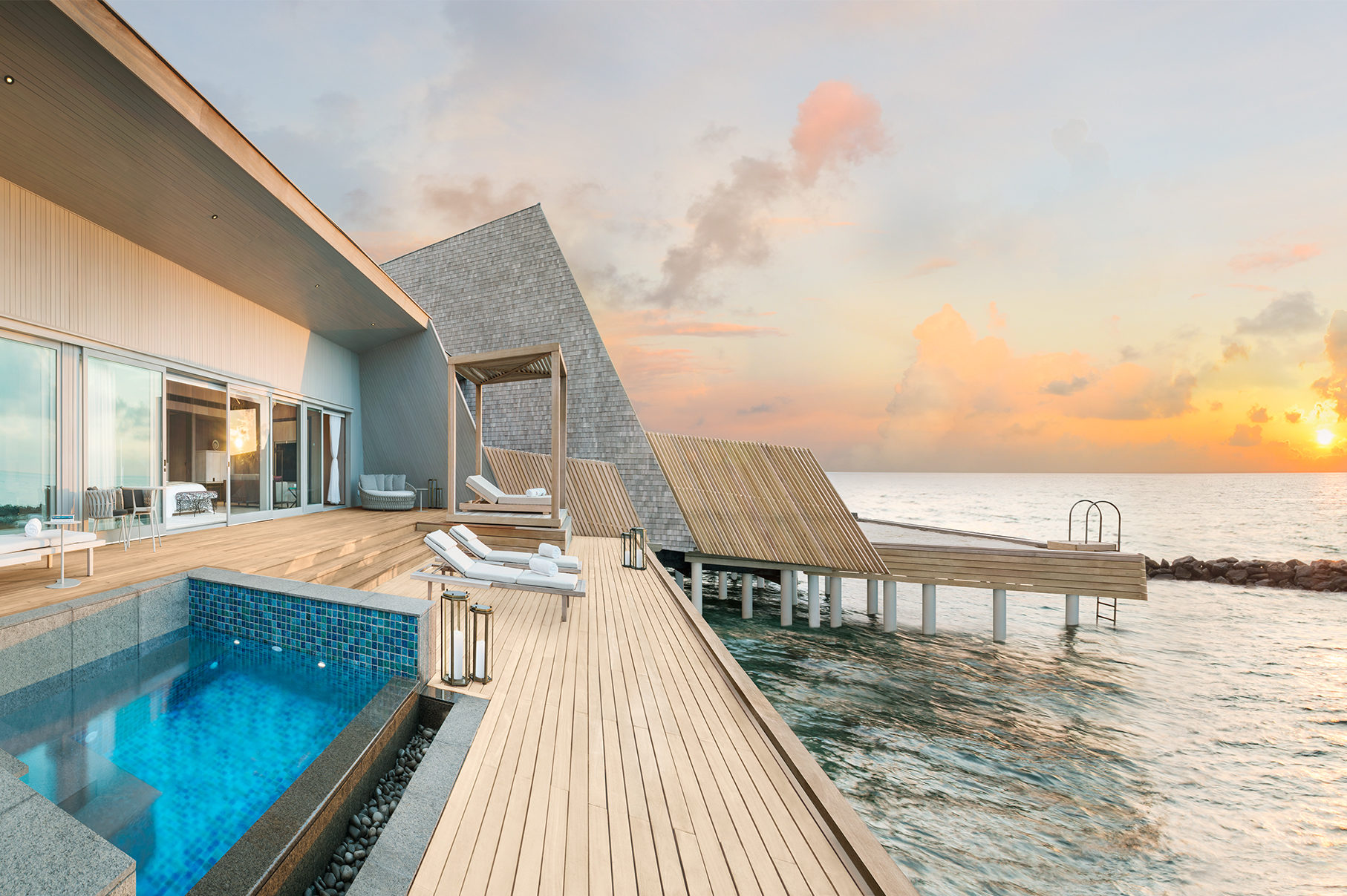
A total of 340,000 points will take some more effort to rack up compared to before, but a couple of signup bonuses on the US side will take care of the difference: you and your partner both grab the Marriott Bonvoy Brilliant Card for 75,000 Bonvoy points and a net US$150 annual fee, each. The total outlay on credit card fees comes to $540 + US$150 (C$198) = $738.
However, if you want to skip all the hassle of nabbing credit card signup bonuses, there’s a shortcut available to those of you who are willing to spend a little more lavishly but still unlock excellent value: buying points directly from the program.
Indeed, the Waldorf Astoria Maldives Ithaafushi costs 120,000 Hilton Honors points per night, which equals 480,000 points for a five-night stay. When Hilton puts on their frequent 100% points-purchase bonuses, you can instantaneously purchase this amount at a rate of 0.5cpp (USD) for US$2,400 (C$3,164).
That’s a fair chunk higher than if you took the time to collect credit card bonuses, but it’s an instant win compared to a concerted effort over six months to a year. And of course, it’s still only a fraction of how much the Waldorf would cost if you paid for it out-of-pocket.
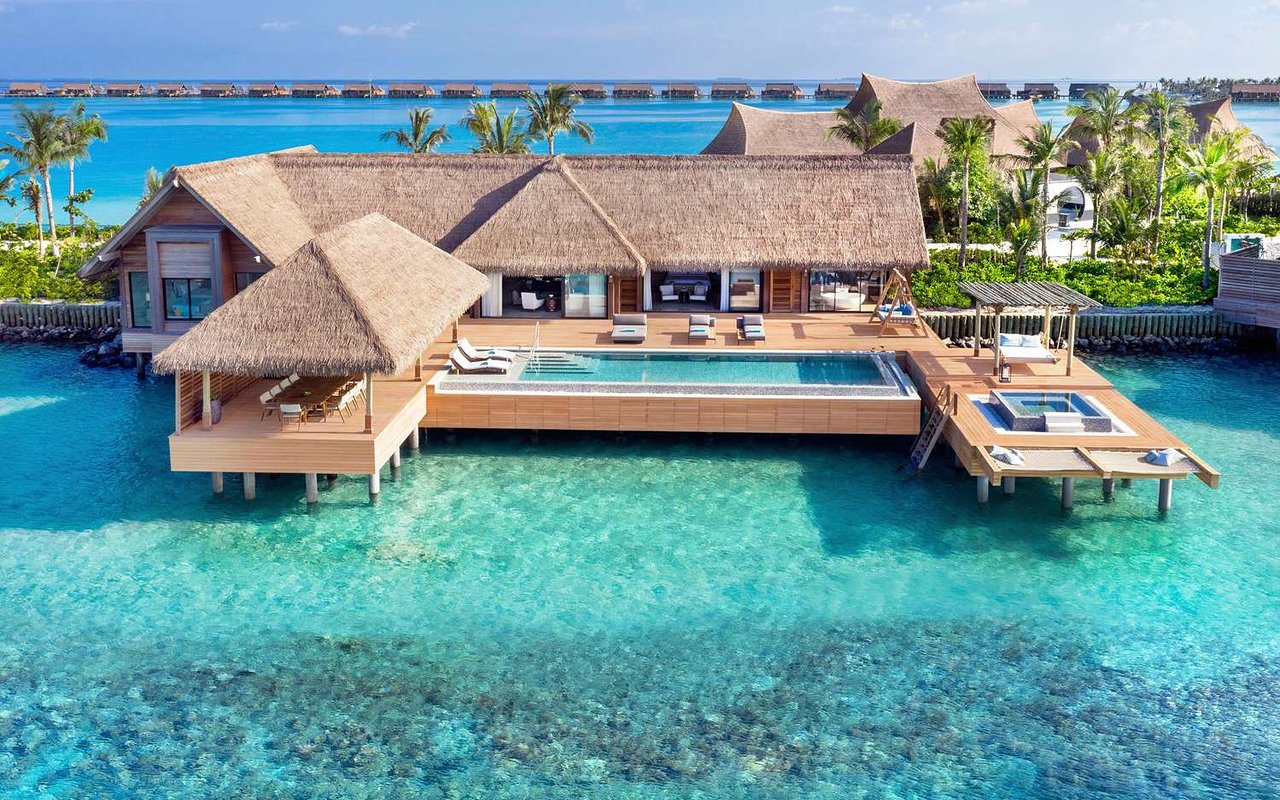
Either way, the room rate is only the beginning. We must now add on either US$745 per person for the St. Regis or US$738 per person for the Waldorf. Let’s call that an even US$1,500 (C$1,980) for the couple.
Then, it’s all about the on-property spending. Since you’re looking to live the life, you’re happy to eat reasonable portions for breakfast before ordering a light burger or Pad Thai for lunch by the pool, even if it costs US$65++ for each portion. Maybe even throw in some appetizers in there for US$20++ apiece.
Dinnertime arrives, and, well, you aren’t going to pass up the opportunity to try out every single fine-dining venue on the property, are you? Between the surf and turf on one evening, and the teppanyaki set meal on another, the food bills easily come to US$200–300 every evening.
And that’s without considering the cocktails, the wines, the champagnes, so another US$100–150 per evening wouldn’t be unreasonable, depending on how much you’re living it up.
(Oh, and don’t forget about the “++”, too.)
Of course, the lavish spending doesn’t end there. There’s no shortage of ways to spruce up your stay further, as long as you’re willing to pay for it.
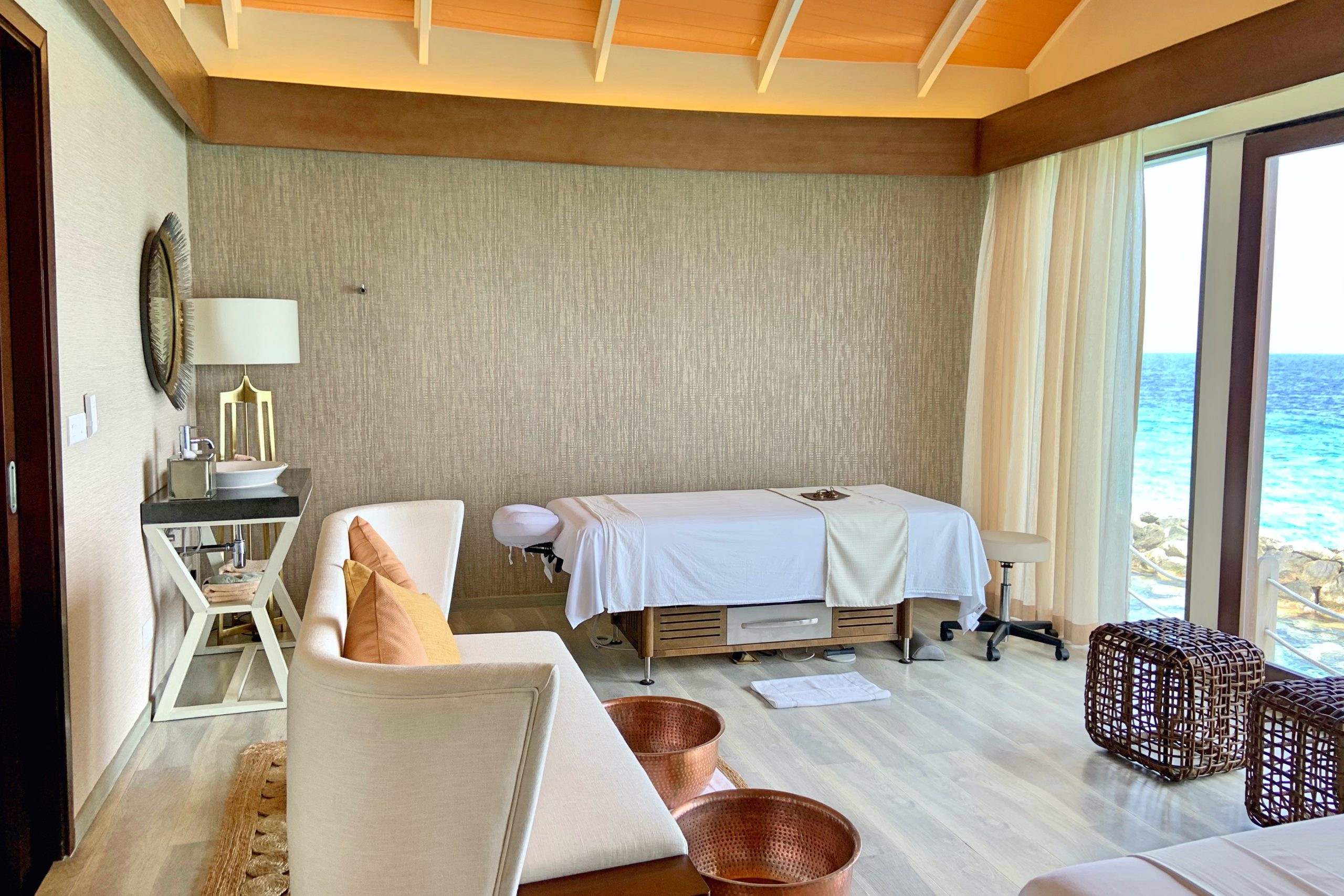
Spa treatments for US$150 per hour? Jetski rentals for US$299 per hour? A big game fishing tour for US$500 for the day? Indeed, a private beachside dinner on a special occasion for an eye-watering US$650 per couple? It can all be yours.
In reality, there’s no real upper limit to how lavish you can make your Maldives trip. Personally, I’ve spoken to people who’ve concluded their stays in the Maldives with final room bills of around US$3,000, US$5,000, and US$8,000… and I could easily imagine those figures getting even higher.
Is a Trip to the Maldives Worth It?
Clearly, this is a question that every traveller can only answer for themselves. I do find it quite interesting to hear the variety of perspectives within the Miles & Points community, though.
Perhaps it’s because the Maldives are so widely regarded as the pinnacle of “aspirational” travel that there’s always a significant divide between those who do set it as their goal for a dream trip, and those who don’t view it as the right fit for their travel styles.
I think a large part of it comes down to your motivations for collecting rewards points in the first place. Are you looking to use points to supplement the exact same trips that you would’ve taken otherwise, or are you looking to use points to unlock special experiences that you could only dream of otherwise?
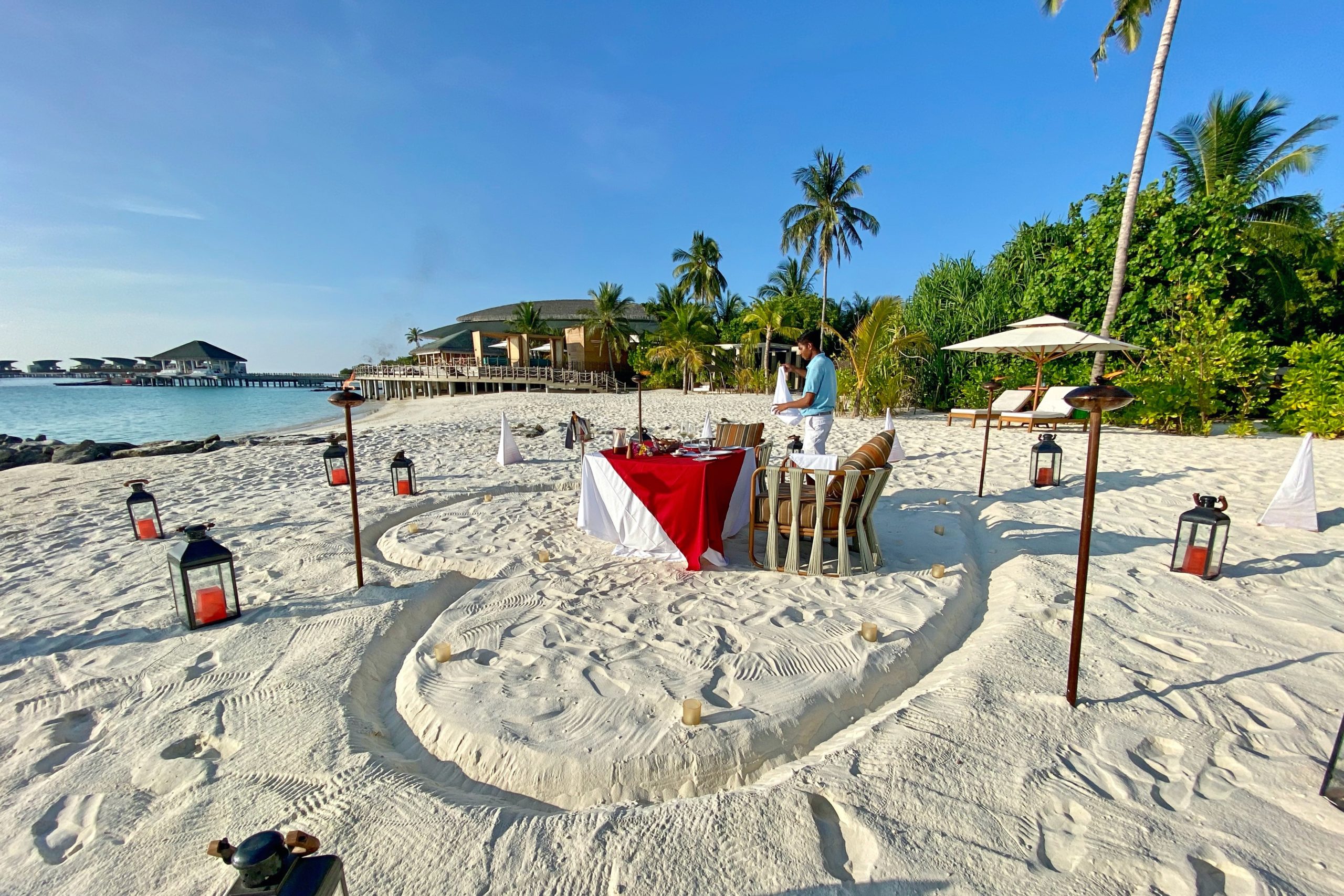
If you’re in the latter camp, the question becomes whether or not you can justify the cost. Certainly, even the low-end costs that we had highlighted – $1,894 per couple – might fall outside of some travellers’ budgets.
However, I also don’t think that a trip to the Maldives is entirely unrealistic for the “average person”, either. If you keep your eyes on the prize and grind away at saving up the points and the cash, then achieving any goal is possible – and armed with a knowledge of Miles & Points, you’ll already spending a mere fraction of the resources compared to the actual “average person” who’d need to pay out-of-pocket.
Ultimately, there’s an element of self-selection as well: it’s precisely because of the exorbitantly high prices of the Maldives’ resorts, that makes it such a special and exclusive experience for those who do put in the work to make their dream trip happen.
For me, the thinking was pretty simple. In the 5+ years that I’ve been earning and redeeming points, a trip to an overwater villa resort in the Maldives has always been one of my ultimate goals, as it’s a trip I’ve dreamed of taking ever since I was a young boy.
Now that I’ve tried it for myself, I can safely say that I fully understand the hype. When I think back to my trip to the Maldives, my thoughts do not drift to the final bill at all, but rather to lifelong memories I made with my significant other, the incredible villas we got to enjoy, and the stunning ocean views that, in my mind, simply cannot be associated with a price tag.
I’d certainly like to visit the Maldives again in the future, and while I know it’ll place another heavy burden on my wallet, I’m content to grind away at building up my cash and points balances in the meantime, because I know the experience will make it all worthwhile when the time comes.
Conclusion
There’s nothing like a dream trip to the Maldives that gets exactly half of the Miles & Points community’s hearts racing, while the other half goes like, “Why would anyone ever spend so much points and money just to bum around in the middle of the ocean?”
If you’d like to visit the Maldives for yourself one day, it’s best to do so with a clear idea of the costs that you should expect. You’ll almost certainly be dropping at least two grand on the trip (and easily a couple more), but if you’re willing to stomach those costs and go through with it, you’ll also come away with the memories of a lifetime and absolutely zero regrets in dropping that cash in the first place.
What do you think? Do you dream of a trip to the Maldives as well, and are you confident of making that dream happen using Miles & Points? Or do you not see what the hype is all about? I’d love to hear your thoughts in the comments below.
















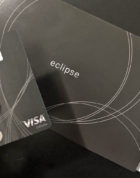



When you said “eye on the prize”. Text exactly what I did with my Bonvoy account the last 3 1/2 years. I am amassed 500k points and I just recently booked the brand new (2022) Ritz Carlton fair Islands.
I booked before Bonvoy adjusted their reward rate and got five nights for only 400,000 points receiving one night free. Taxes fees and transfers was around $1800 US. We are flying from Chicago to Dubai by means of emirates. And staying four nights in Dubai with my Hilton points for free. The remaining five days will be taking another Emirates flight to MLE.
With airfare and cash incidentals we are budgeting 8 to $10,000.
Keep in mind the cash rate for the Ritz Carlton Maldives in February came to over $17,000 US.
I can’t wait to see the beautiful city of Dubai and experience the Maldives and the way you put it, it’s a destinations that separates bucket list dreamers and doers.
Cheers
👏 That’s what we like to hear!
Thanks for breaking this down! Super helpful 🙂 Hopefully I’ll get to the Maldives one day
Brianna
Thx for the info Ricky!! Hopefully in 3 yrs we can do this trip.
A lot will change in 3 years. Expect increased rates by that time.
Cinammon Maldives – short boat ride – all inclusive amazing food and drink, beautiful overwater bungalow, less than CAD4000 for a week. Almost never ran into other guests.
Next trip stayed at the Sheraton – horrible place.
Say no to western chains!
I am looking to get into US credit cards but unfortunately having trouble with obtaining a EIN or ITIN. Any suggestions on what avenues to get those?
Thanks for writing this up, Ricky! I was hopeful about staying in an overwater villa in the Maldives, but seeing these numbers makes me realize that it may not be the best option for me.
And that’s totally fair. Anyone who might harbour aspirations of taking a trip to the Maldives should have a clear idea of what costs to expect. However, don’t forget that there are also plenty of cheap guesthouses on some of the islands closer to Malé that still provide a spectacular setting.
as a traveler for many years I now avoid areas like Maldives. too many forced choices prior. once booked, you are trapped.
not worth the effort- so easy to find ‘perfect’ view, ocean, privacy etc an hour from any major terminal.
maybe, as I am in my 50’s(yeh, kids), I’ve done the far far away and am over the days of travel to get there for the one second of , ‘oh, nice view’, now what.
I take the kids to a city, where they remember the people, the smell, the humanity, not the staff.
Totally see your viewpoint, Jeff, as another city lover myself. In fact, most of my trips involve spending time in cities, but sometimes I’m tempted enough by an exclusive resort to post up for a couple of days. 🙂
I’d love to know more about the places you’ve gone, Jeff. Interesting to take a different point of view for travel.
I believe the Sheraton does not charge for the transportation anymore. It is a good place for an overnight stay if you get to mle late in the day.
If you stay at the SAii Lagoon you can go to the mall or restaurants on the island and eat there. Coupled with the lower cost transfer it’s probably the most frugal option.
We’ve been to the Maldives 2x as a family of 4, and the kids are still longing to go back. Our strategy is a little different: Use points for flights on business class and book directly with resorts using cash. In this way, you are not “stuck” with the mega hotel chains. We’ve tried out COMO and Anantara, and they usually offer 1/2 or full board packages (maybe even kids eat free or 1/2 off speedboat transfers). The Discovery Loyalty (Anantara) offered some interesting perks where we got free massages or local excursions.
Thanks for the suggestions, Mer, gives me a lot more options to consider for next time.
Nice to see someone else takes the kids too! We stayed at the Conrad as a family of 4 on points but that seaplane from Male is a killer for a family. Transmaldivian needs to join Star Alliance!
Wouldn’t that be nice!
Thanks for doing this article. I’m considering spending on a “Fly & Dine” package. Seems reasonably priced (for Maldives) at $6500 for 5 days at the W which includes 3 meals daily and the flight transfer fees for 2 people. I bet most likely, the resort will find ways to entice me to open up the wallet (drinks not being included) so i figure I can expect to tack on another $1000. Now, I figure if I went the credit card route and hit the MSR needed to get the points, I’d probably need to spend a similar amount (either alone or in 2 player mode) so I figure I’d go the Fly & Dine route and earn the points (almost half way to a future 5 night stay!) So many variables and calculations to consider! But I think either way, it’s a worthwhile trip.
They are most certainly very adept at enticing guests to open up the wallets. 🙂
Finding a lucrative cash deal is the other angle that i haven’t explored in this post, although for some folks it’ll make sense.
I think a trip to the St. Regis Bora Bora is in order for you as a point of comparison. 😉
My parents paid $2.6k USD for 6 nights above the points cost, including the resort transfer (but not the inter island flight), confirmed upgrade for 4 nights and then food and non-alcoholic beverages. Definitly wasn’t a “deal” but having VAT and gratuity included in the prices with only a small additional gratuity if desired makes prices more reasonable at first glance.
And to think, that WA MLE yacht transfer price is the lowered rate, used to be $861. Price you pay for exclusivity 😉